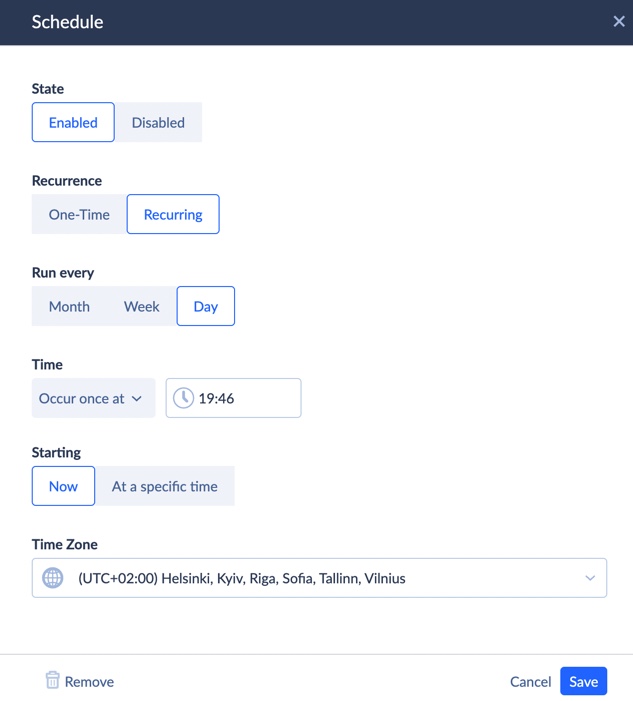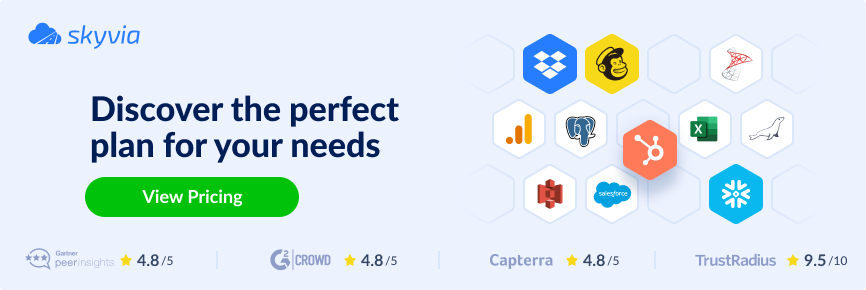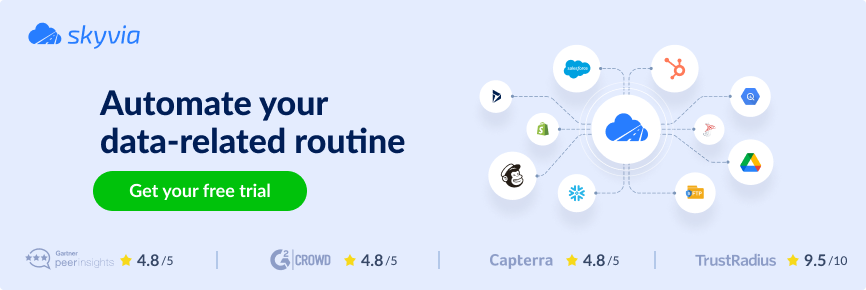The first data integration mentions emerged right after the invention of floppy disks. People used floppy disks as an intermediary tool for copying information from one system to another, but that took lots of time and resources.
Things got better in the 1990s when the first extract-transform-load (ETL) tools appeared. They were much more convenient than floppy disks, though they required a very complex architecture and infrastructure stack.
The rise of cloud computing and the internet has been continuously transforming the field of data integration since 2009. Data warehousing, implementation of AI and ML, and even self-service platforms rock the data integration sphere today. Find all these and other data popular integration trends in this article.
Table of Contents
- Exploring Data Integration
- Critical Role of Data Integration for Business
- Emerging Data Integration Trends
- Conclusion
Exploring Data Integration
Believe it or not, organizations use around 130 apps on average in their daily operations. Imagine the amount of data generated every day in those SaaS platforms and desktop applications.
However, unsystematized bulk data isn’t very informative, so it’s better to organize it well. A great way to do that is by combining data from various sources with the data integration mechanisms applied.
Let’s look at some popular definitions of data integration by tech giants of today.
“Data integration is the process of bringing together data from different sources to gain a unified and more valuable view of it so that your business can make faster and better decisions.” Google
“Data integration is the process of discovering, moving, and combining data from multiple sources to drive insights and power machine learning and advanced analytics.” Google
“Data integration refers to the process of combining and harmonizing data from multiple sources into a unified, coherent format that can be put to use for various analytical, operational and decision-making purposes.” IBM
“Data integration is the process for combining data from several disparate sources to provide users with a single unified view.” Microsoft
To combine and harmonize data from multiple sources into a unified format, data integration techniques evolve. Below you’ll find the most common approaches going in line with data integration trends.
- Traditional ETL relies on three fundamental stages: 1) extraction, 2) transformation, and 3) loading of data. It pulls out data from selected sources, applies cleansing to match the target data type, and loads it to the destination system.
- ELT is a newer and more flexible alternative to ETL, with the same stages, though loading precedes transformation. This approach appeared as a response to big data. Its aim is to load high-volume unstructured datasets to the target system.
- Data warehousing uses either ELT or ETL to consolidate data in a data warehouse, usually for business intelligence purposes.
- Data virtualization, unlike the methods mentioned above, doesn’t imply physical movement and copying of data. Instead, it creates a virtual view across multiple data sources. It serves as an access point for applications, queries, reporting tools, etc.
- Change data capture (CDC) identifies and tracks changes in data warehouses and databases. It allows companies to achieve data integrity and consistency across multiple systems.
Those concepts and approaches are widely used in data integration tools such as Skyvia – a universal SaaS data platform designed for a wide set of data-related tasks.
One of its products, named Data Integration, has everything needed to perform seamless migration and elaboration of data across multiple systems.
Skyvia’s Data Integration product embeds the following tools:
- Import is the ETL-based tool for migrating data between cloud applications, databases, and data warehouses.
- Export extracts data from cloud apps into CSV files that can be saved on a computer or cloud storage.
- Replication is the ELT-based tool for copying data from cloud apps into data warehouses and databases. It uses the CDC approach to capture data differences when making incremental updates on schedule.
- Synchronization coordinates data in different sources to make sure it’s aligned. It also uses the CDC to identify which data was changed in one source and make the appropriate changes in another.
- Data Flow allows users to build more complex data pipelines, including several sources, and apply multistage data transformations like lookup and expression.
- Control Flow creates logic for task execution, performs pre- and post-integration activities, and configures automatic error processing logic.
Data Flow and Control Flow offer advanced data integration features available under paid plans. Other integration scenarios are available for free, so you can start experimenting with your data now!
Critical Role of Data Integration for Business
Data integration positively impacts the overall efficiency and productivity of any business. It helps both startups and large corporations to drive insights from consolidated data and make smart decisions. The most tangible advantages associated with data integration:
- Enhanced data quality. Data integration tools standardize data, making it clear to understand and ready to use for business intelligence (BI).
- Data-driven decision-making. Cleansed and standardized data becomes a solid foundation for machine learning, robotics, and other modern technologies. They accompany BI, which helps businesses make informed decisions.
- Resource saving. The initial investment in data integration affects the total cost of ownership (TCO). However, the results are just around the corner. You’ll get immediate insights into which actions to take, which products to improve, and how to make your business more profitable and improve ROI.
- Data security. Modern data integration tools implement encrypted channels for data transfer between sources.
Let’s examine Cirrus’s case study, which depicts how the company uses data integration daily. They needed to bring data from Stripe, QuickBooks, and SQL Server into Salesforce customer records. With the help of Skyvia, they managed to set up everything without the IT specialists intervening. As a result, Cirrus saves a lot of time and money, keeps data clear and correct, and makes informed decisions.
Emerging Data Integration Trends
No matter whether a company operates in the ‘red ocean’ with harsh competition or the ‘blue ocean’ being a monopolist in the niche, it certainly has a lot of data to manage. Data integration can be compared to the tree pole that helps businesses cope with data; technologies are its branches, and the trends are fruit.
Below, you’ll find emerging data integration trends, starting from the cloud to self-service platforms. Depending on which fruit you expect, select those trends that will help cultivate the crops.
Cloud and Data Integration: Emerging Patterns and Trends
Amazon Web Services, Google Cloud, Azure Cloud, IBM Cloud, and other similar solutions have completely changed how companies build and organize their infrastructures. More and more businesses decide to bring their operations to the cloud to take weight off their shoulders and stop configuring on-premises architecture. Some enterprises still use so-called hybrid infrastructure combining cloud and on-premise elements for security reasons.
Cloud technologies grant scalability, flexibility, and cost-effectiveness, which is critical to modern businesses. They also make a foundation for all other data integration trends, providing the needed architecture and features.
The Rising Wave of Real-Time Data Integration
The slogan “Citius, Altius, Fortius” no longer refers only to the Olympic Games but to the real business world. Companies are craving to be leaders and thus do everything for that. They perform real-time monitoring of KPIs, performance, market trends, and other critical aspects that may impact business growth and success.
Real-time data integration usually requires complex infrastructure and architecture solutions. The most popular trends in real-time architectural frameworks are:
- Event-driven architecture is based on the events that trigger certain actions in the system. It’s rather effective in working with data from heterogeneous sources and of different types.
- Microservices architecture presumes that each process is an individual unit running in a separate container. It provides more agility in working with various data types and integration requirements.
- Stream processing frameworks like Apache Kafka are designed to handle data streams in real-time.
- Cloud-native architecture supports applications deployed in the cloud and provides scalability, resilience, and elasticity for them. Such applications as Skyvia run in the cloud environment and thus handle any data loads.
Real-time integration might be of particular interest to companies working with IoT (Internet of Things), patient surveillance, the financial stock market, and digital marketing.
AI and Machine Learning in Data Integration Processes
Data integration also has its challenges and uncertainties. Low-quality data or wrong data format are among them and become especially tangible when mapping source fields to the destination fields on integration setup. Data integration tools aren’t always capable of detecting low-quality data or mismatched formats, but machine learning can help. It usually comes embedded into data integration tools for detecting and signalizing data discrepancies.
To make things clearer, let’s look at the example of when marketers register phone numbers in the 000-000-0000 format in HubSpot. Meanwhile, salespeople register phone numbers in the 000 000 0000 format in Salesforce. When bringing data from both systems together, an integration error will likely occur. The role of AI and ML is to detect and predict possible inconsistencies and apply the necessary measures to map data between sources correctly.
The Surge in Popularity of Embedded iPaaS Platforms
The term iPaaS is an acronym that stands for integration Platform-as-a-Service. It offers all he necessary services to seamlessly integrate applications and platforms in the cloud.
The embedded iPaaS platform is usually an in-built solution inside another software product. It enables users to access embedded applications directly inside the software.
Such embedded iPaaS systems benefit particularly SaaS companies. They already provide easy-to-use app integrations that can be adopted inside a SaaS application. This also reduces the time for development for SaaS companies.
Self-Service Data Integration on the Rise
Floppy disks are in the past, while self-service data integration platforms shape the future. They represent an innovative approach toward data integration and maintenance.
Self-service data integration platforms are particularly helpful for non-tech business users. Owing to the no-code and zero-maintenance approach, users with no programming experience can build their data pipelines. Self-service tools incredibly speed up the processes and effectiveness of marketing and operation departments. They can perform any data integration task without any help from the IT guys.
Enhanced Commitment to Safeguarding Data
Data security is another concern associated with data integration, maintenance, and processing. Modern data integration tools implement secure mechanisms for safe data transfer in the encrypted using HTTPS protocol and SSL certificate. They also ensure role-based access control (RBAC) that provides each user with a set of permissions. There are also audit trails that log user actions to detect who accesses data and what actions are performed on it. Such monitoring procedures detect any anomalies and potential security breaches in real-time.
Scheduled Data Processing
Given the rising popularity of real-time data, data integration tools implement appropriate scenarios for dealing with it. They ensure proper transfer and processing of big data in real-time. For instance, Skyvia can perform data transfer in batches each minute, which is close to the real-time pace. Just click Schedule when setting up the integration scenario and select the frequency and timing for data integration.

Note that such near-real-time integration is possible under the Professional pricing plan. A free version of Skyvia allows only one scheduled data transfer a day, which is suitable for daily reports and data updates. See other Skyvia pricing plans to understand where to start.
Blockchain Integration and Beyond
Cryptocurrency isn’t the only sphere embracing blockchain technology. Data integration also heavily relies on it to enhance data security.
Complex cryptographic mechanisms, hash function, and chain structure ensure data blocks are highly protected. Moreover, the blocks in the blockchain are stored across various locations over the network. This concept eliminates a single point of failure and enhances data availability.
Conclusion
We’ve presented the most recent and actual trends in the data integration market:
- real-time streams
- ML and AI for data mapping
- self-service and iPaaS platforms
- cloud services
- blockchain technologies
- etc.
The good news is that you don’t have to take many different actions to implement each of these trends. Just try out Skyvia, which goes in line with most of the modern data integration trends. It offers near-real-time data transfer, a self-service approach with no coding knowledge needed, smart data mapping, scheduled data transfer, and data safeguarding.


